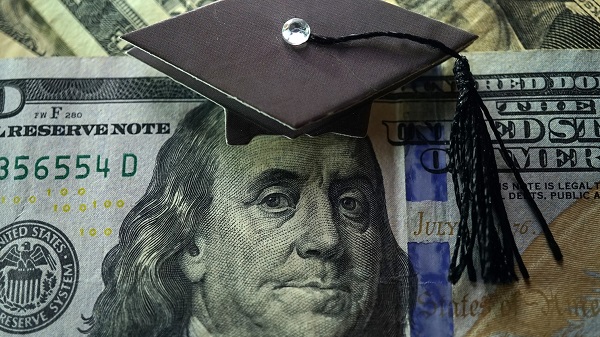

Angle

The Future of Student Loans and Bankruptcy – Is There a Bubble Waiting to Burst?
- Bankruptcy
- 9 mins
In March 2021, the U.S. Department of Education noted that student loan borrowers owed $1.6 trillion federal and private loans. For many, loans are the only option to attend a U.S. university or college for undergraduate, graduate, and professional studies. However, after graduation, many individuals are unable to secure jobs in their fields that pay enough to support the cost of living and pay off these student loans. This leaves many people believing that the country is experiencing or at least approaching a student loan bubble, which by definition is when the price of something substantially exceeds the value. With extremely limited bankruptcy relief available, the student loan bubble could burst and have serious economic consequences. Some new case law and proposed legislation may alleviate these affects, but only time will tell.
The State of U.S. Student Loan Debt
As student loan debt continues to rise, the notion that there is a bubble about to burst seems more plausible. The debt problem exists at every level. For undergraduate studies, there is insufficient education for teenagers and young adults about the long-term effects of taking out loans. They are unaware about how interest rates work or what future payments will entail. The hard truth is that many will not get a job paying enough out of college to expeditiously pay off the loans, which results in interest capitalization and heavier debts. Even at advanced education levels, where more sophistication and knowledge exists about student loan payments, people are still willing to take out loans to pay their expensive education bills. Put simply – without medical and law school, there are no doctors and lawyers. The price tag is also much higher on these degrees with limited scholarship opportunities, so without other financial means loans are the only remaining option. All of these constraints are creating an atmosphere that could discourage people from seeking out higher education, which would greatly affect the job market in certain sectors.
Seeing the struggles of people currently dealing with student loan debt could also disincentivize people from going to college. Some individuals are struggling to manage other payments like phone bills or rent, have lowered credit scores, get fees or wage garnishment for failure to make payments, or are unable to purchase a house. All of this results in a lot of student loans going into default or never getting repaid. If this is in fact a bubble, it may be a while before things actually burst and it is hard to tell what this would even look like. There have been several proposed solutions, but they all carry some risk and there is no guarantee that it would solve this problem. For example, debt cancellation would come at a price with tax implications while putting a stricter cap on federal student loans could dramatically affect college enrollment. Some other ideas include providing more education to students before they take out loans, removing interest rates from federal student loans, and reforming current bankruptcy laws. Again, while these actions would have consequences, it could help curb the student loan dilemma and avoid a larger economic ruin in the future.
Recent Legal Developments
Bankruptcy Case Law
When it comes to bankruptcy, the general rule has historically been that most student loans are not dischargeable in bankruptcy. Under Section 523(a)(8)(A) of the U.S. Bankruptcy Code the following are exempt from discharge unless the debtor can prove undue burden, which is a high bar to meet: federal educational loans; an obligation to repay funds received as an educational benefit, scholarship, or stipend; and any other qualified private educational loans. On July 15, 2021, the Second Circuit delved into the meaning of the second exception on this list in the case of In re Homaidan and held that some private student loans can in fact be discharged in bankruptcy. This will become important precedent for bankruptcy cases involving certain private student loan debts.
Homaidan had filed for Chapter 7 bankruptcy in 2008 and after it was discharged, loan servicer Navient (previously Sallie Mae) sought collection for the $12,000 debt he owed on a private student loan. This was a direct consumer loan with no involvement from his college financial aid office. It also exceeded the cost of tuition and was direct deposited into his personal bank account. There was never any litigation over whether the student loans were discharged in the bankruptcy case, so Homaidan repaid the loans in full. In 2017, he asked to reopen the bankruptcy case to get a determination that the loans were actually dischargeable. He also filed an adversary suit against the loan servicer, who moved for a dismissal that was ultimately denied. The bankruptcy court concluded that not all educational loans were blanketly exempt from discharge and when this issue went up on appeal, the Second Circuit agreed.
The court found that deeming the term “education benefit” to encompass all private student loans did not make sense because Congress would have just used more specific language if this was their intent. Additionally, there would be no need for the other two categorical exceptions because if the term educational benefit was read in broad terms it would swallow up the other exceptions. The court instead looked at the language contextually and concluded that this applied to benefits like conditional grants, which meshes better with the terms scholarships and stipends that were also included in this exception. Two other circuits have ruled in the same manner, so this may indicate a shift towards more leniency from bankruptcy courts due to the looming student loan bubble.
However, it is important to remember that this decision is definitely limited, as a lot of other educational loans will still fall under the discharge exceptions. Many loans are federally funded and there is currently no relief available. Additionally, the Supreme Court has never weighed in on how to interpret the “undue hardship” language that renders the exceptions inapplicable. There is currently a circuit split on this issue, with some requiring the debtor to show total incapacity to pay the student loan debt while other courts take a less strict approach. Regardless, cases like Homaidan definitely provide more avenues for some student loans to be discharged and may keep encouraging other courts to explore the undue hardship issue or even strengthen the push for total reform in this area of bankruptcy.
Potential Legislation and Administrative Action
On July 30, 2021, legislation was introduced in Congress that would view private student loan debt through the same lens as other private debt during a bankruptcy proceeding. If passed, the Private Student Loan Bankruptcy Fairness Act could limit the financial fallout of a private student loan when someone faces a life-changing obstacle like a layoff or personal accident causing them to turn to bankruptcy. Unlike federal loans, private student loans do not offer protections like deferments, alternate payment arrangements, and loan forgiveness programs. Even though these options are narrowly available for federal student loans, they are generally nonexistent with most private loans. Because of this, members of Congress who back this bill explained that private student loans should be treated like any other private loan in a bankruptcy case and therefore be eligible for discharge. If passed, this should lower the risk of individuals avoiding higher education and also put a check on lenders so they do not prey on borrowers in desperate need of funding for their education.
There has also been talk about widespread debt cancellation, but as of now President Biden has only shown support for $10,000 per borrower. While some members of Congress are pushing for up to $50,000, the Administration is not keen on this because of the grave financial consequences it could have on the economy and individual taxpayers. Nothing has come into fruition, so it will be interesting to see if this solution gains any traction in the coming years. One thing the new administration has done is allowing full cancellation from some borrowers that can show misleading information from their colleges about future costs and employment opportunities. While this will only apply to a small fraction of borrowers, it is still another thing that could stop a bubble from growing and eventually bursting.
Additionally, the new Education Secretary recently eliminated a rule enacted under the previous administration that limited state regulation over student loan servicers. In March 2018, the U.S. Education Department issued guidance stating that the act of states regulating federal student loans impedes uniquely federal interests. Now, the new approach is for states to collaborate with the federal government to combat fraud and abuse from loan servicers to provide greater borrower protection. The new guidance notes that while sometimes federal law will still preempt state law, the states can still regulate student loan servicers when it comes to consumer protection. This includes matters involving deceptive practices, payment errors, unanticipated fees, paperwork mistakes, and similar actions. There will be opportunity for public comment and future guidance on how federal and state laws interact on this issue. A handful of states currently mandate servicers to periodically provide reports to shine light on any service breakdowns or other issues. A couple states require that loan servicers pay for an operating license, which allows for loan monitoring and compliance investigations. It will be interesting to see how many more laws like this emerge in the near future based on the Education Department’s new stance.
More recently, on August 19, 2021, the Biden Administration announced that it will be automatically wiping out the federal student loan debt of $5.8 billion for 323,000 borrowers. The administration will be cancelling borrowers’ federal student loan debt through the Total and Permanent Disability (TPD) discharge program. The TPD Discharge program allows student loan borrowers who are unable to maintain substantial, gainful employment due to a physical or psychological medical impairment to get their federal student loans cancelled. However, to get student loans forgiven under the program, disabled student loan borrowers must submit a formal application, which can be challenging for those facing serious health issues, and many borrowers may not even realize that they qualify.
The new guidance has not been welcomed by everyone and could revert if and when the Administration changes again. Opponents to this action believe that forcing federal loan servicers to succumb to a variety of state laws that may go against federal regulation will only make things more complicated and can result in more issues for borrowers trying to repay their loans. Advocates of this change agree that the Education Department not often lead the way in regulatory advisement but see state intervention as a way to ensure that enforcement is carried out and borrowers are treated fairly in the servicing of their loans. If this is successful and fraud or improper loan handling is decreased, the risk of borrower default should lessen. This could be another factor to stop the student loan debt bubble from growing and create a better atmosphere for borrowers to successfully manage their payment obligations.
If you enjoyed this blog, consider reading The Future of Subchapter V: Navigating the Pandemic and Beyond
The contents of this article are intended to convey general information only and not to provide legal advice or opinions.
